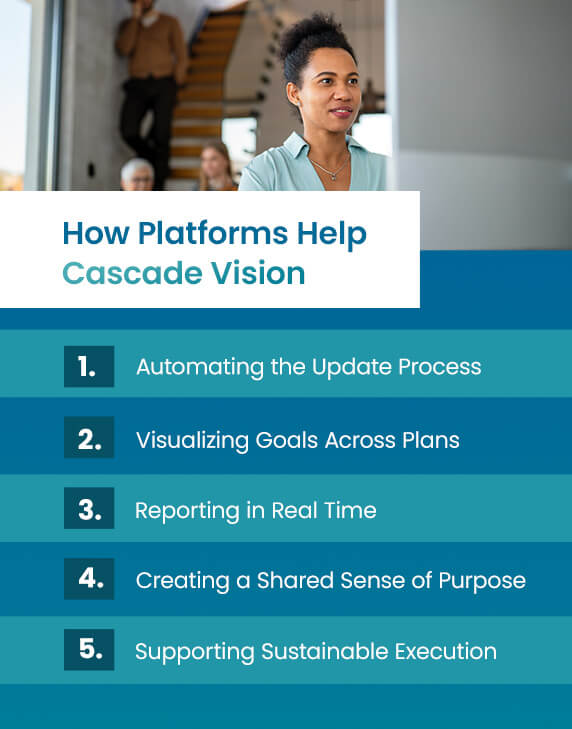Most strategies don’t collapse because of poor ideas — they collapse because employees never understand why the strategy matters. Just telling teams to do something fails to provide motivation. Why should employees care? Why shouldn’t they just do the bare minimum? Without a clear sense of purpose, even well-funded initiatives stall.
The Chief Strategy Officer (CSO) is the lead communicator. They translate vision and strategy into meaning that powers everyone in your organization to act. This cascading vision trickles down from the CSO, motivating the entire team. But cascading vision requires structure. Platforms that provide transparency and alignment help CSOs connect purpose to execution, securing the buy-in needed for real results.
In This Article
- The Critical Role of Communication in Strategy Execution
- The CSO Communicating Strategy and Driving Organizational Buy-In
- Why Organizations Need the “Why”
- Challenges CSOs Face in Communicating Cascading Vision in Organizations
- How Platforms Help Cascade Vision
- Ensuring Buy-In Across the Organization
- Measuring the Impact of Strategy Communication
The Critical Role of Communication in Strategy Execution
Communication is the difference between success and failure. Even with all the planning in the world, 60% to 90% of strategic plans never get off the ground — not due to flawed planning, but because of breakdowns in execution.
When communication works well, every person sees how their role links to broader goals. They understand why a shift in priorities is happening. They know how you’re tracking progress. But when communication breaks down, organizations see consequences like:
- Low morale: Employees who feel disconnected from the strategy are less motivated and less likely to take initiative.
- Misalignment: Teams might pursue conflicting objectives or duplicate work. Departments will take on less important tasks. Employees need clarity about why something matters.
- Stalled initiatives: Strategy never goes exactly as planned. External conditions change, and teams need continuous communication to adapt. Otherwise, you get delays and failures.
When you focus on employee success, your organization does better. Companies that focus on employee performance see an average 30% higher revenue growth. When everyone’s on the same page and supported, they lift each other up. However, that alignment is reinforced only with consistent messaging and visible progress. For CSOs, that means building a shared understanding so every person can act in service of it.
What Is Cascade Vision?

To cascade vision is to take an organization’s high-level vision and communicate it down through every level of the company. With this approach, executives understand how departmental goals tie back into the vision. From there, managers translate departmental goals into team objectives. Finally, employees see how their work connects to the overall strategy or vision. The idea waterfalls down from the top until every employee clearly understands its relevance to their role.
The CSO Communicating Strategy and Driving Organizational Buy-In
While the Chief Executive Officer (CEO) sets the vision and the leadership drives functional goals, the CSO is responsible for implementing that vision. They convert high-level direction into actionable priorities and keep the “why” visible across all organizational levels. This comes with three core responsibilities — clarifying goals, aligning departments and managing accountability. CSOs must communicate the objectives and keep everyone on the same page. They track progress and create an environment where results take priority.
Securing Emotional Buy-In
Those three responsibilities are the easy part of a CSO’s job. The more challenging part is securing the emotional buy-in, which is the foundation of every strategy. Employees who understand the purpose behind your strategy will invest in it and innovate when challenges appear. Businesses with more engaged employees see higher productivity.
That’s why a CSO must focus on employee engagement strategy. How are you getting teams to connect to your goals? Highlight the tangible impact of initiatives and connect daily tasks to this overall goal. The tools they use should amplify clarity while reinforcing the buy-in. With these measures, CSOs can turn a strategy from an executive plan into a collective movement.
Why Organizations Need the “Why”
Every strategy begins with a set of goals, but goals are not enough to sustain action for long periods. Understanding why the work matters drives people to invest their energy and creativity. The psychology of purpose is well-documented. Employees who see meaning in their work are more engaged and resilient to challenges. Purpose fuels motivation far better than compliance.
Generational and cultural shifts have altered this further. Millennials and Gen Z employees want to work for organizations with clear missions and values. They’re not satisfied with meeting targets — they want to know how they make a difference. If leaders can’t connect strategy to purpose, they risk losing top talent.
The benefits of emphasizing the “why” go beyond morale. Organizations with high engagement see better business outcomes, such as:
- Fewer safety incidents
- Lower turnover
- Stronger profitability
- Less theft
For CSOs, this translates into faster execution and employees who rise to and overcome challenges. When employees understand the “why,” they turn it into a shared drive for success and a motivation that makes every other part of strategy execution possible.
Challenges CSOs Face in Communicating Cascading Vision in Organizations
Even the most skilled leaders hit barriers when trying to implement their strategy for communication cascade. CSOs must create a great plan and ensure people understand and believe in it. Here are some common challenges CSOs face:
1. Siloed Communication Channels
Many organizations still operate in departmental siloes. Each function relies on its own tools and processes to function. This fragmentation makes it difficult for messages from leadership to reach everyone consistently. Employees often receive incomplete information. They must work in the dark or chase down answers from different leaders.
2. Overreliance on Static Presentations and Email
Slide decks and all-staff emails are a staple of organizational life, but they don’t drive engagement. Static documents don’t update and are easy to lose. Employees can’t interact with the message or ask questions. How does the strategy connect to their daily work? They must go to their manager or further up the chain to find out.
3. Inconsistent Messaging Across Departments
When different leaders hear the vision, they might interpret it uniquely. Five people might take away five different objectives. Then, they send these mixed messages to employees. Inconsistency creates confusion and slows execution. Teams suddenly work toward slightly changed objectives. CSOs need a unified narrative to keep everyone aligned.
4. Difficulty Tracking Engagement
How do you know the strategy has landed with teams? Did employees understand it? Do they feel connected to it and want to support it? CSOs need ways to measure interaction and feedback. A systematic approach — like a transparent communication platform — can provide visibility into understanding and sentiment.
How Platforms Help Cascade Vision
Cascading your vision across an organization takes work. CSOs can state the big picture, but need consistent delivery and reinforcement with tools. Otherwise, the message becomes diluted as it moves through leadership layers. Transparent communication platforms provide the structure needed to make visions accessible, measurable and actionable.

1. Automating the Update Process
Manual update chasing is time-consuming and fragmented. Leaders track progress through spreadsheets, calls and status reports. By the time they’re done, everything might be outdated. A transparent communication platform eliminates this by automating update collection. Team members receive reminders and input updates. Everything flows directly into reports and dashboards. CSOs can focus on decision-making instead of data handling.
2. Visualizing Goals Across Plans
Most organizations juggle dozens of initiatives. Platforms let leaders manage these plans from multiple views — tree, list, timeline or dashboard. CSOs can easily confirm how projects align with broader goals and see where bottlenecks are forming. Visualizations are especially powerful for connecting individual contributions to strategy. Employees can see exactly how their work fits into organizational objectives.
3. Reporting in Real Time
Instead of waiting weeks for teams to compile reports, platforms generate tailored dashboards instantly. These reports combine updates and metrics, making tracking performance across an organization easier. Custom widgets and multiplan views allow leaders to drill into specific initiatives while watching the big picture. CSOs can spot risks early and celebrate wins when they happen.
4. Creating a Shared Sense of Purpose
Technology can even influence work culture. Making progress visible to everyone helps with fostering shared purpose in organizations. Employees no longer feel like their work exists in a vacuum. Instead, they can see how their contributions connect across departments. Seeing their influence builds project momentum and reinforces company bonds.
5. Supporting Sustainable Execution
Finally, the right platform goes beyond helpful tools. It should also come with expert support for onboarding and plan optimization. That way, CSOs can successfully structure and execute plans. Otherwise, strategies are slowed down by onboarding time and confusing learning stages.
Ensuring Buy-In Across the Organization
Beyond tools that help leaders maintain momentum, your company needs everyone to buy into the agenda. Just telling employees the new direction isn’t enough — CSOs have to get people to want to hit the goals. Achieving buy-in means talking to teams and building a culture that works for success. That means involving top-level employees and working to build up everyone.
1. Working From the Top Down
Buy-in starts at the top. If executives and department heads aren’t aligned, the message quickly fractures as it cascades. A strong strategy for C-suite buy-in ensures that leadership consistently supports the narrative. Employees notice when leaders don’t commit. This makes them lose faith in the mission and are more inclined to distrust the company’s goal.
2. Engaging Employees in Strategy

Genuine buy-in goes beyond compliance. Employees must feel a sense of ownership in the process. This is where employee engagement in strategy execution comes in. Employees feel more invested when they can see the direct impact of their contributions, provide feedback, and celebrate milestones. Platforms that give teams visibility into progress make this possible. Seeing results motivates and helps teams believe in the mission.
3. Being Transparent
Nothing undermines a buy-in like radio silence. If employees feel unseen, they’ll think they don’t matter and become demotivated. They need ongoing updates that show how and where their efforts are making an impact. Transparent reporting keeps everyone informed and shows them how the strategy is progressing. Use automated updates, dashboards or scheduled summaries to maintain momentum.
4. Recognizing Wins and Addressing Challenges
Buy-in is also about celebrating wins and being honest about setbacks. Publicly recognizing wins reinforces desired behaviors and shows that leadership values progress. Acknowledging challenges openly is also essential. This shows accountability and prevents rumors from filling in the silence. Employees value communication, and telling them when there’s a setback shows them you trust them.
5.Creating a Culture of Shared Ownership
Seeing how your work ties into organizational goals is motivating. Make sure to emphasize how success is achieved through everyone’s efforts. This shift from disconnect to shared ownership transforms goals from executive order to shared mission. You’ll keep the buy-in sustained long-term instead of making it a one-time event.
Measuring the Impact of Strategy Communication
Clear communication is essential for buy-in and strategy execution, but how do you know if your efforts are working? For CSOs, that means finding metrics to track and measure. Without the right metrics, knowing whether employees are engaged and on track is impossible.
Why Measurement Matters
Strategy execution consumes time, resources and attention from the entire organization. Boards and executives expect evidence of progress. Measuring impact lets CSOs spot early warning signs and demonstrate success. Otherwise, it takes too long to spot off-track work — and then you’ve lost even more resources to the wrong direction.
Key Indicators of Communication Effectiveness
Use these indicators to assess whether the CSO’s strategy message is resonating:
- Departmental alignment: Do leaders and teams consistently reference the same goals and priorities in meetings and reports?
- Engagement: Do employees open, respond to or interact with strategy communication?
- Contribution clarity: Can employees explain how their work ties into organizational goals? If not, communication is falling short.
- Progress: Are projects moving as planned? Are bottlenecks popping up frequently due to confusion or misalignment?
The Role of Platforms in Misalignment
Traditional methods like surveys offer insight, but they’re inconsistent and anecdotal. Platforms provide a solution to your measurement inconsistency by tracking work daily. Automated updates, requests, dashboards and reporting provide a continuous data stream. Leaders can see progress being made and whether communication is landing. They know who’s responding, how quickly and with what results.
Using Data to Strengthen Strategy Execution
Measurement shouldn’t be about just compliance. Instead, CSOs can use these insights to adjust communication approaches and find success areas. Making progress visible emphasizes the “why” and helps leaders reinforce accountability. Plus, data show you the tangible value of effective strategy communication.
Reach Your Full Potential With AchieveIt

Successful execution calls for a strong structure and motivation. AchieveIt’s strategic planning software helps organizations connect, manage, and execute their most important initiatives in one platform. By eliminating manual processes and centralizing updates, AchieveIt gives CSOs the visibility and accountability they need to keep strategies on track. We back our solution with dedicated experts who guide plan setup and adoption.
AchieveIt is here to help your organization stay on track. Request a demo today and see how to turn vision into measurable results.



